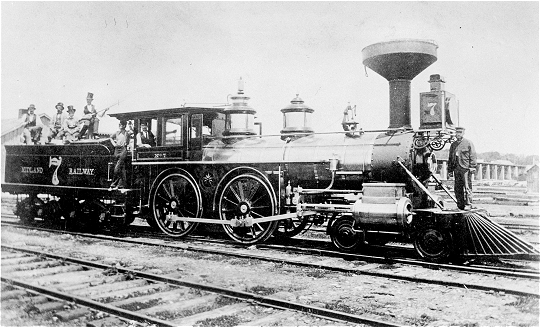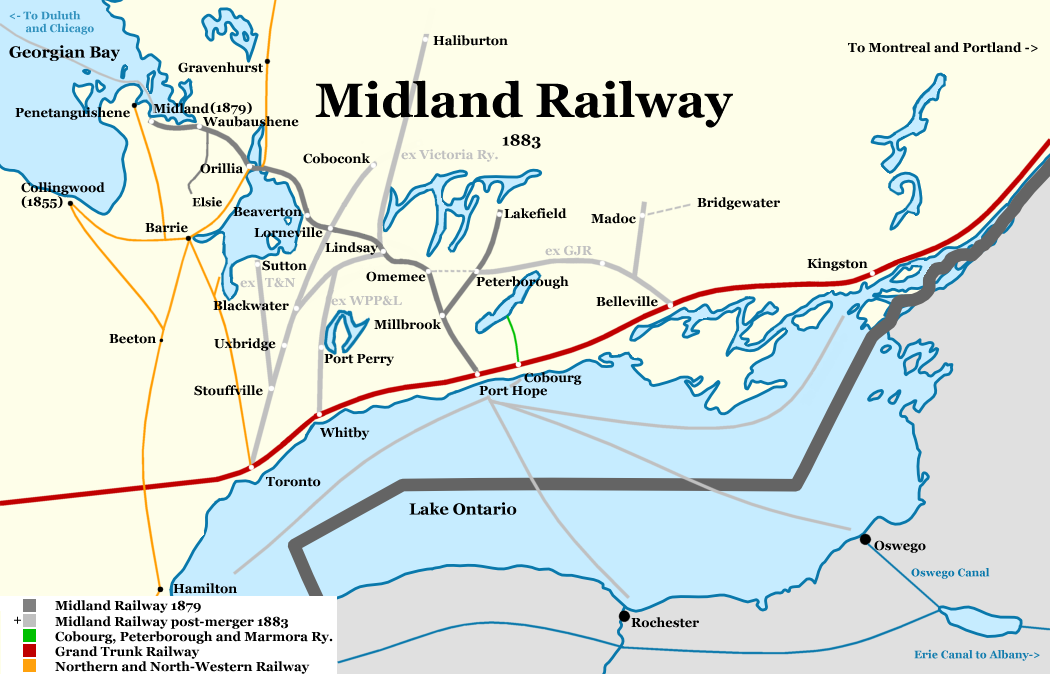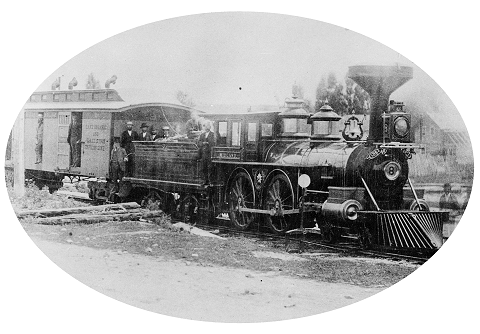Hello, and welcome to my Virtual 3d Model Railway!

Mildland Railway of Canada Engine "No. 7" at Port Hope Harbour - National Archives of Canada C-023248
Rails to Midland is a window into my ongoing digital model project of what once was the Midland Railway of Canada, and the towns and villages through which it ran in the back townships of central Ontario. If you are in interested in the early-Canadian railway history, or the history of the region in general, you may find the model and website of interest.
Based on the Trainz railroad simulator platform, the work is built upon an digital elevation model of the terrain along the route of the railway. A topographical map is rendered on the surface of the model to facilitate accurate placement of the rail, road, and water networks. From this template the build began along the swath of land centered by the railbed. A vast array of in game tools are used to sculpt and paint the terrain and build the transportation infrastructure, while third party 3d modelling and paint software are used to create buildings and other objects unique to this model. I have also utilized a large library of quality models created by other enthusiasts that have saved me a lot of time and added greatly to the detailing of the model.
To be specific about the window-in-time that this small part of the world is modeled, in its current form the year 1883 most closely matches the layout of the railway and make up of the towns and villages along the route. By this point in time, the Port Hope based railway had reached it's objective of Midland Bay and had added the necessary port facilities, including a grain elevator, to serve as an appropriate terminus for in-game railroad operations. Other reasons include the addition of a by-pass of the old rail line through Lindsay, Ontario, that I wanted to include; the Medonte Tramway which began operations in 1883; the steamship Lady of the Lakes(formally Emily May) being taken out of service; and the conversion from narrow gauge to standard gauge of the old Toronto and Nipissing Railway line which had, along with four other roads, formally consolidated with the Midland Railway of Canada a year earlier. I am however more interested in going back in time than into the coal burning era, therefore most of the buildings and rolling stock, as well as the layout of the towns, are made with that in mind. I spent a lot of time recreating the older part of the town of Lindsay for this purpose.

The Towns, Villages and Terrain along the route.
Looking at the map you will notice the home town of the railway, Port Hope, on the shore of Lake Ontario. From here the line runs north along the scenic Ganaraska Valley for a few miles and then continues to climb to a spot south of Millbrook called "Summit", where on the picturesque grounds the company picnics were held. The line moved north form here through the town of Millbrook where there was a sawmill located at the site of the station. This is where the first railway bridge to cross the Scugog river at Lindsay was framed. North of Millbrook the line branched off along an unremarkable path to Peterborough; the largest town on the rail line. Beyond Peterboro' the branch passed the saw mills at Nassau and took a scenic run up the Otonabee River to Lakefied. Back on the mainline, the road runs northwest of Millbrook and then basically follows the path of, what is today, Ski Hill Road into the village of Omemee. This section north of Bethany is where the old grade against traffic was prior to reconstruction. The line then heads northwest predominantly through rich farmland all the way to Beaverton. The town of Lindsay was the third largest town on the rail line, a center for lumber transhipping; lumber milling and distribution; and the future hub of railway operations in the region. Just west of Grasshill is the summit of the entire line (995ft) between Port Hope and Midland, and further west is the junction with the Toronto & Nipissing section of the Midland. The Nipissing section is constructed in the model between the villages of Argyle and Woodville. Between Beaverton and Orillia the highlights are few, with a short run along Lake Simcoe to begin the journey and then a long stretch through swamps and brushland with a few farms along the way. There was a gradient of 1.23% beyond the base of the Talbot river, but not against the bulk of the traffic heading east. On the approach to Orillia the scenery improves beginning with the crossing of The Narrows at Atherley. Orillia is a picturesque town especially so along the waterfront. At the time Orillia was said to be a model small town with the main street shaded with trees west of the station. A major source of raw material for the wood milling industries in the area was the Black River, which has it's headwaters in the Haliburton region. Northwest from Orillia there was a grade to the summit near the Muskoka Road/Hwy 11, and primarily bush beyond that point with a few sawmills built along the route. At Coldwater the scenery again improves, with a branch running south along the Medonte Valley to, what is today, the Elsie tract of Simcoe County forests. The tramway ran through the "clayfields" south of Coldwater, then along the base of the ridge where the Mt.St Louis Moonstone ski resort now resides, further on behind the old church that still stands today, and then up a steep gradient to the lumber mill. The mainline from Coldwater was built on an easy-going stretch along the scenic shores of Georgian Bay, with more than a few saw mills along the waterfront, to the terminus village of Midland City, named after the region and railway. Midland would become a major port on Geogian Bay for the through-grain trade to eastern markets, and the area in general home to some of the largest lumber operations in Canada.

Click on the image to view full Grand Trunk Summer Resorts Review
All in all not the route of the Rocky Mountaineer, but in general a scenic trip across what was referred to by many at the time as the Midlands of Ontario. This region would include Port Hope and surrounding area, and then north into the back townships including all of the Midland(Kawartha) Lakes; more so than the Simcoe County townships and the actual town of Midland. Back in the days when Ontario was Upper Canada(1791-1841), there was a Midland District further to the east between Belleville and Kingston and northwards, while the district that included Port Hope, Cobourg, Lindsay and Peterborough was named Newcastle. It seems that the Port Hopers had adopted this name at some time after Upper Canada was renamed Canada West(1841-1867), as more than a few companies located in the town had "Midland" in their name including, of course, the railway; years prior to the naming of the town on Georgian Bay. Midland Hotels were popular along the line too, with one in Port Hope, Orillia and, of course, Midland City. The Midland Regiment originated in Cobourg in 1866.
Buildings and Structures
Most of the prominent buildings of the day that were directly adjacent to the right-of-way-have been constructed for the model, and a few off in the distance as well. My general rule however is to only create building that were directly adjacent to the track and to utilize generic buildings at a distance. Otherwise, the project would never be completed. While a number of Victorian-style Ontario homes have been modeled, they are, with a few exceptions, generic and therefore used throughout the model. The railway stations and structures, such as bridges, have been reconstructed to the best of my knowledge. A few of the stations I have build are based on the old Fenelon Falls design that was rebuilt after the Midland/Grand Trunk gained control. The station still stands with modifications made later by the Grand Trunk Railway. Similar designs that I know of were built at Keene and Uthoff. In general the stations with Italianate-style windows such as at Beaverton, Blackwater, Peterborough, and Orillia, are Midland Railway designs. The brick stations at Waubaushene and Brechin are Midland designs during the Hugel presidency, and the late half-hip roof models are Grand Trunk Railway designs.
As for the industries I have made an animated lumber mill circular saw with carriage and log slip. The thought of recreating all of the lumber mills along the route is somewhat daunting, but I will be able to reuse the mechanics in future structures. There are numerous factories in the old part of Lindsay, and I'm looking forward to building the grain elevators in Midland and Port Hope.
Locomotives and Rolling Stock

No. 8 "Midland" - built by the Portland Company in 1872 - National Archives of Canada C-023240
The locomotives I have constructed for the model were manufactured by the Portland Company in Portland, Maine, at the end of the Grand Trunk Railway line. These locomotives were also used on the connecting Grand Trunk, Grand Junction, Whitby and Port Perry, and Victoria railways. The Whitby and Port Perry had attempted to undervalue a brand new Portland locomotive when passing through customs at Port Hope, claiming a worth of only $2,000 to save on fees. Unfortunately for them, the agents had seen an identical engine, purchased by the Midland Railway, arrive during the previous week valued at $10,000. Early Portland Company locomotive lithographs and coloured photographs were referenced for the different colour schemes.
A locomotive purchased by the company at startup, the "Havelock", was one of the first to be produced at the Morton Works in Kingston, Ontario. I was unable to locate any images from the initial production of locomotives in Kingston, but apparently there was something unique about the bell. I hope to make a later model engine from that company at some point in time - perhaps for the Northern Railway in Orillia. The very first engines designated to the road were purchased by the contractor who constructed the line, Samuel Zimmerman, and were manufactured by the Amoskeag and Manchester Companies in New Hampshire. The "Clifton" was named after the town overlooking Niagara Falls that Zimmerman had invested heavily in.

Amoskeag built 4-4-0 with inside connection - similar to the "Clifton" locomotive
Being primary a lumber and timber carrier, as many of the early-Ontario railways were, there was always an abundance of flat or platform cars on the road. Many of these cars were built at the facilities in Port Hope and Cobourg for the Midland Railway. The boxcars ranged between 30ft-40ft in length and from what little information I can gather had "Georgian Bay Line" painted on some of the through-traffic cars after the merging of services with the Grand Trunk Railway. The Grand Trunk cars are numbered according to the era in which they were built. I painted a few "Hoosac Tunnel Line" cars in honour of Frank and Walter Shanly, even though it would have been unlikely to see them as regulars on the Midland line. All of these cars had hand brakes, and I would venture to say, based on numerous accident reports in the newspapers, that carrying out the duties of the railway brakeman was the number one cause of human injury on the entire line .
The History of the Midland Railway of Canada
The history of how the line was built is quite interesting as it took quite some time to complete. With the ownership changing hands numerous times, a general lack of investment by the municipalities outside of Port Hope, and the infrequent highs and prolonged lows of the economy, it's a wonder how the road made it the shores of Georgian Bay. I have provided a short history of the line to completion and while still somewhat independent of the Grand Trunk Railway. Please refer to the history page.
Videos
Currently I can showcase the model through a few videos, of what will eventually be a series, featuring train rides though adequately completed sections of the model. Looking at the map you can see where the model has been constructed to date, and the section of track you can take a trip through. As I have engineered the video myself, I was able to place cameras at intervals along the line so to include structures not exactly adjacent to the railbed, which is something you may not have the advantage of if you were always riding in the cab of the locomotive or one of the passenger coaches. Of course, making the route available for others to operate via the train simulator is a part of the ultimate goal. Please refer to the videos page for downloads.
Futures Developments of the Model
I was initially going to build the Cobourg and Peterborough Railway, and if not for the endless springtime repairs on the bridge over Rice Lake, would probably have been finished by now! However, there is no turning back now, therefore the short term objective is to further construction towards Midland. Please refer to the "News" page for updates on construction progress.
Beyond reaching Midland, the long term plan is to work up from Port Hope.
Until then, enjoy the videos!
Copyright © Stephen M. Farrell 2019 All Rights Reserved
Some of the text, images and videos on this website are not public domain, please contact me for permission to use material on this website.